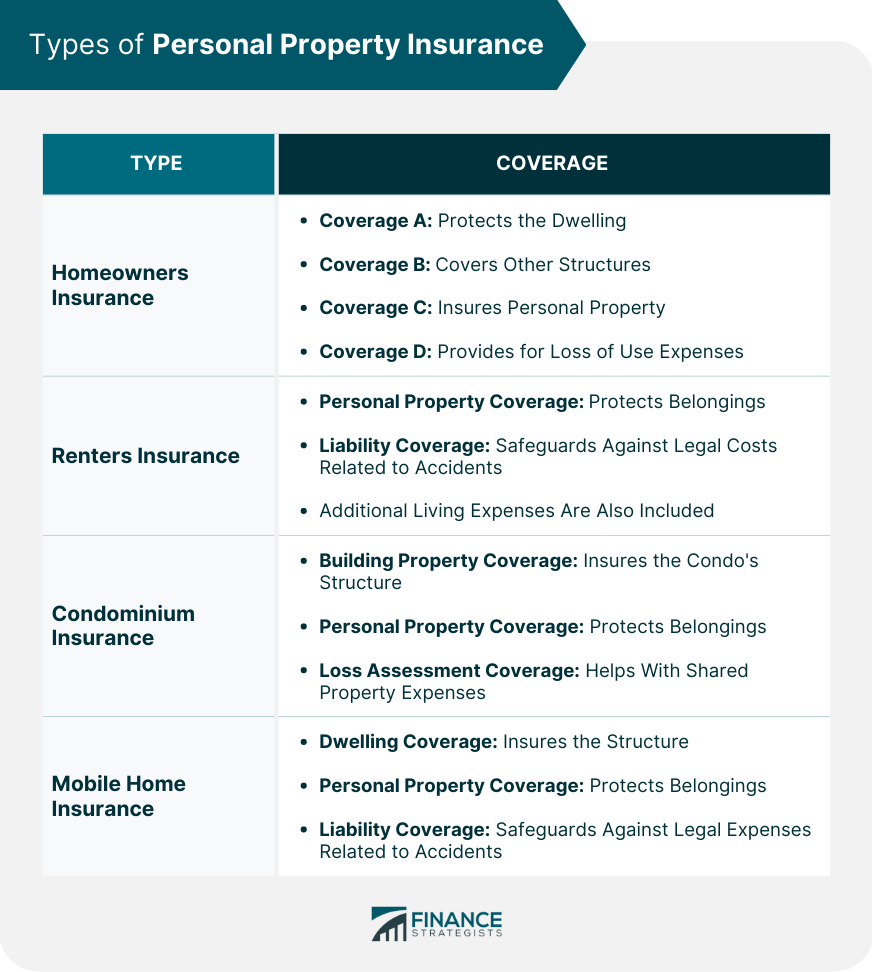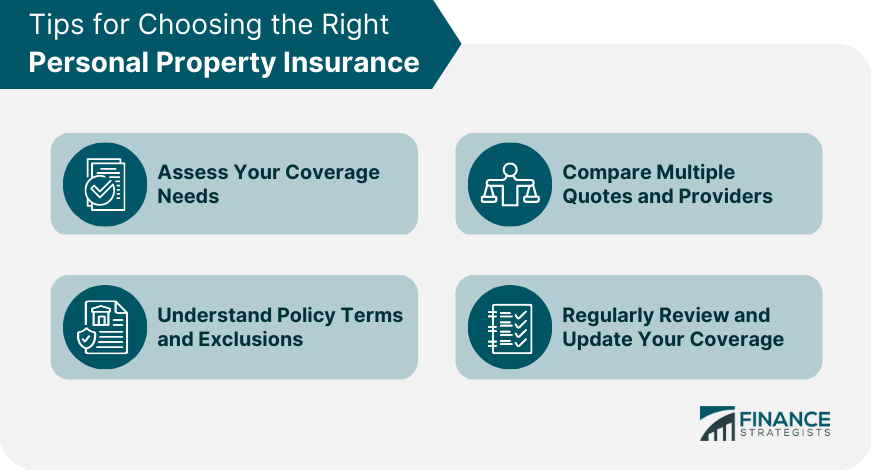Personal property insurance protects your belongings in case of damage or theft. It's essential to understand the basics of this coverage and why it's important. Personal property insurance provides coverage for your belongings inside your home, such as furniture, electronics, and clothing. The purpose of this insurance is to provide financial protection in case of damage or loss due to perils like theft, fire, or certain weather events. Having personal property insurance is crucial, as it helps you replace or repair your belongings in case of damage or loss. Without this coverage, you could face significant financial strain in the event of an unexpected incident. Different types of personal property insurance cater to various needs, such as homeowners, renters, and condominium owners. Explore the options available to you. Homeowners insurance is a policy that covers your home and belongings against damage or loss. Coverage A protects the dwelling, Coverage B covers other structures, Coverage C insures personal property, and Coverage D provides for loss of use expenses. Renters insurance is designed for tenants, covering their personal property and providing liability coverage. Personal property coverage protects belongings, while liability coverage safeguards against legal costs related to accidents. Additional living expenses are also included. Condominium insurance is tailored for condo owners, offering protection for the building, personal property, and loss assessment. Building property coverage insures the condo's structure, personal property coverage protects belongings, and loss assessment coverage helps with shared property expenses. Mobile home insurance is designed for mobile and manufactured home owners. Dwelling coverage insures the structure, personal property coverage protects belongings, and liability coverage safeguards against legal expenses related to accidents. Understanding the value of your personal property is crucial for choosing the right insurance coverage. Consider actual cash value, replacement cost value, and appraisals. Actual cash value (ACV) is the depreciated value of an item at the time of loss. ACV takes into account the age and wear of an item, potentially resulting in a lower claim payout. Replacement cost value (RCV) is the amount needed to replace an item with a new one. RCV does not consider depreciation, providing higher claim payouts compared to ACV. Regular appraisals and home inventory records help determine the value of personal property. They provide an accurate estimate of your belongings' worth, ensuring appropriate coverage and claim payouts. Several factors influence the cost of personal property insurance. Consider location, type of residence, deductibles, and security features when evaluating premiums. The location and neighborhood of your residence affect insurance premiums. High-crime areas or regions prone to natural disasters typically have higher insurance costs. The type of residence influences insurance premiums. Detached homes, apartments, and condominiums have different risks, which can impact insurance costs. Higher deductibles and coverage limits can affect your personal property insurance premiums. Choosing a higher deductible can lower your premium, while increased coverage limits may result in higher premiums. Installing security and safety features, such as alarms and fire sprinklers, can lower insurance premiums. These measures reduce the risk of damage or theft, making your property a lower risk for insurers. Understand the common exclusions and limitations in personal property insurance to ensure adequate coverage. Be aware of high-value items, natural disasters, maintenance issues, and intentional damage or illegal activities. High-value items, such as jewelry, art, or collectibles, often have coverage limits in standard policies. You may need additional coverage or endorsements to ensure adequate protection for these items. Some natural disasters, like floods or earthquakes, may not be covered under standard personal property insurance policies. Separate policies or endorsements might be necessary to protect your belongings from these perils. Damage resulting from poor maintenance or neglect is typically not covered by personal property insurance. Regularly maintaining your property and addressing issues promptly can help prevent such exclusions. Intentional damage to your property or damage caused by illegal activities is not covered under personal property insurance. Engaging in such activities could result in denied claims and even policy cancellations. Filing a claim involves several steps, such as taking immediate action, documenting the damage, and navigating the claim process. After a loss, contact your insurance provider immediately and secure your property to prevent further damage. Timely reporting and taking appropriate action can expedite the claim process. Gather documentation and evidence, like photographs or videos of the damage, to support your claim. Providing thorough documentation can help ensure a fair and timely settlement. The claim process typically involves an adjuster evaluating the damage and determining the claim payout. Understanding your policy and providing accurate documentation can result in a smoother claim process and settlement. Selecting the right personal property insurance requires assessing your needs, comparing quotes, understanding policy terms, and regularly reviewing your coverage. Identify your coverage needs based on the value of your belongings, potential risks, and desired claim payouts. Understanding your needs will help you choose a suitable policy. Comparing quotes and providers allows you to find the best coverage and price for your needs. Researching and shopping around can help you make an informed decision. Thoroughly read and understand your policy terms and exclusions to avoid unexpected coverage gaps. Knowing your policy's limitations can help you make any necessary adjustments or add endorsements. Review your coverage regularly and update it as needed to reflect changes in your belongings or living situation. Staying up-to-date with your coverage ensures you have adequate protection for your personal property. Personal property insurance is a type of insurance policy that provides coverage for your personal belongings against damage, theft or loss. There are different types of personal property insurance, including homeowners insurance, renters insurance, condominium insurance, and mobile home insurance, each catering to specific needs. The advantages of personal property insurance include peace of mind, financial protection in case of unexpected events, and the ability to customize coverage to fit individual needs. However, the disadvantages include the cost of the policy, the need for an inventory of belongings, and the possibility of inadequate coverage. Overall, personal property insurance can be a valuable investment for protecting your personal possessions, but it is important to carefully evaluate your options and choose the policy that provides the best coverage for your needs and budget.What Is Personal Property Insurance?
Types of Personal Property Insurance
Homeowners Insurance
Renters Insurance
Condominium Insurance
Mobile Home Insurance

Determining the Value of Personal Property
Actual Cash Value
Replacement Cost Value
Appraisals and Inventories
Factors Affecting Personal Property Insurance Premiums
Location and Neighborhood
Type of Residence
Deductibles and Coverage Limits
Security and Safety Features
Common Personal Property Insurance Exclusions and Limitations
High-Value Items
Natural Disasters
Maintenance Issues and Neglect
Intentional Damage and Illegal Activities
Filing a Personal Property Insurance Claim
Immediate Steps After a Loss
Documentation and Evidence
Claim Process and Settlement
Tips for Choosing the Right Personal Property Insurance
Assess Your Coverage Needs
Compare Multiple Quotes and Providers
Understand Policy Terms and Exclusions
Regularly Review and Update Your Coverage

Conclusion
Personal Property Insurance FAQs
Personal property insurance is a type of insurance policy that covers your personal belongings from theft, damage or loss.
Personal property insurance typically covers items such as furniture, electronics, clothing, and jewelry, as well as other personal possessions in your home.
The value of personal property insurance is based on the value of your belongings. It is important to keep an inventory of your belongings and update it regularly to ensure you have adequate coverage.
Yes, if you are renting an apartment or a home, you should consider purchasing personal property insurance to protect your belongings in case of theft or damage.
To find the right personal property insurance policy, you should consider factors such as coverage limits, deductibles, and premiums, and compare policies from multiple insurance providers before making a decision.
True Tamplin is a published author, public speaker, CEO of UpDigital, and founder of Finance Strategists.
True is a Certified Educator in Personal Finance (CEPF®), author of The Handy Financial Ratios Guide, a member of the Society for Advancing Business Editing and Writing, contributes to his financial education site, Finance Strategists, and has spoken to various financial communities such as the CFA Institute, as well as university students like his Alma mater, Biola University, where he received a bachelor of science in business and data analytics.
To learn more about True, visit his personal website or view his author profiles on Amazon, Nasdaq and Forbes.















